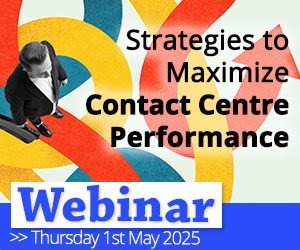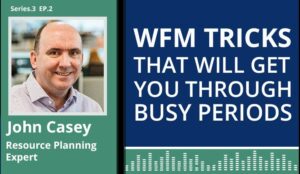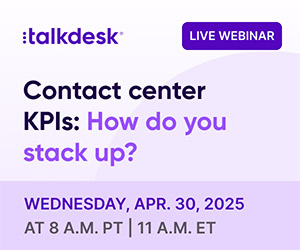Call centres are fast-paced environments that rely on efficiency, teamwork, and quick response times to provide great customer service, but some agents develop clever tricks to avoid calls.
While some methods are easy to spot, others require deeper monitoring. This article highlights common call avoidance tactics, how to detect them, and strategies to help avoid these behaviours.
Call Centre Tricks to Avoid Calls
1. Switching Between Available and Unavailable
If your telephony system allocates calls according to which advisor has been available the longest, as most do, then this is an easy system to manipulate to avoid taking calls.
On a quiet day, when there are several people on ‘idle’ status (perhaps in both senses of the word), setting yourself to unavailable for a few seconds, then back onto available again, can shuffle you from the front of the queue for the next call, right to the back.
This is the easiest and most obvious way of slacking off and call avoidance. It’s easy to find an excuse to be offline for less than a minute: taking off a jumper, getting a new notepad from the stationery cupboard, getting a glass of water or uncoiling a headset wire will do the job.
How to Spot It
Always look for patterns. If you can view the status logs for an individual advisor whom you suspect to be shuffling, the pattern is easy to see.
Look for the shortest periods of unavailable time – the ones that last only seconds. If most of them are preceded by long periods on available status, you’ve got a shuffler.
2. Not Ending a Call When a Customer Disconnects
Contact centre advisors rarely end a call themselves – they say goodbye, the caller hangs up and the line goes dead. Sometimes, though, the line doesn’t go dead. The caller has gone, but the line remains open. It just hangs.
If you were an honest advisor with a good work ethic, you’d hit the ‘terminate call’ button and move on to the next one. The alternative, though, is to just sit and chill out for a while.
According to any kind of telephony software, you are still ‘on a call’ and working hard, so no one is likely to ask why on earth you are sitting there doing nothing.
The same principle applies when transferring a call, as the original advisor could keep the line open while a second advisor handles the query.
How to Spot It
It’s very difficult to know when a member of your team is using either of these tactics. If you regularly walk the floor and evaluate call recordings, you might spot it now and then. If you don’t do one or the other, it’s probably happening a lot more than you think.
3. Pressing Mute and Pretending There Is a Fault on the Line
If an advisor wants to take a break during a call instead of waiting until the contact is resolved, some individuals may fiddle with the mute button.
This will either extend handling time, with the advisor being able to take quick breaks to perhaps check their phone, or, as is more likely, the customer will hang up and maybe call again.
The advisor will then move to the back of the advisor queue, while the contact centre cannot be sure as to whose line was faulty and may not be able to tell during quality monitoring sessions.
How to Spot It
The first stage of detecting this trick would to be listen for moments of silence during a call, either through call listening and monitoring or by detection via a speech analytics platform.
While this may not draw any immediate conclusions, as analysts may not be able to spot whose line was at fault, looking out for patterns of repeat incidents will provide you with a good idea.
4. Rounding Up Breaks
When does a break start? Is it the moment you click the ‘unavailable’ button, or is it when you physically walk out of the office?
It’s an important distinction, because there are plenty of time-wasting opportunities with the latter.
If your lunch break is at midday, you can come off the phones bang on the hour, then go report something minor to your supervisor, quickly reply to an email, get your sandwich out of the fridge, put your coat on then walk out the door, looking at your watch and thinking “right, I left the office at ten past twelve”.
If you do something similar when you return from break, you could feasibly eke out a half-hour lunch break into fifty minutes off the phones.
How to Spot It
Very easy. If it’s happening, then you already know about it. The harder bit is stamping it out. If it has always been an accepted part of the office culture, then a very clear line must be drawn to put an end to it.
5. Making After-Call Work Personal
Some calls require a minute or two of after-call work, just to tie up the admin – some don’t.
But unless you are being directly monitored, supervisors have no way of actually knowing which calls require after-call work and which don’t.
So if you want to send a personal email, check the footie scores, find some juicy celeb gossip online or just sit there for a bit, you know there is that one or two minute pause after each call that is never going to arouse suspicion.
How to Spot It
Internet histories, email monitoring or screen recording (if you have it) are the best ways. It sounds like a lot of work to be constantly scrutinising your advisors’ logs, but you don’t have to actually do it – just say you will. The ever-present possibility of a surprise inspection is often enough of a deterrent.
6. Tactical Toilet Breaks
Now here’s a difficult one to enforce.
If an advisor goes wandering for a full ten minutes and then tells you they were on a ‘bathroom break’, are you really going to ask for all the gory details of how those ten minutes were spent?
Six of those ten minutes could have been spent leaning against the sinks, texting or Twitter surfing, safe in the jurisdictional blackout zone of the ladies’ or gents’.
How to Spot It
We all know how long a toilet break should take, even the (ahem) lengthier ones. Spotting tactical toilet breaks and enforcing them are totally different propositions. If you’re the boss then it’s your choice, but it’s a can of worms that few are willing to open.
How to Avoid It
I noticed a lot of employees taking long toilet breaks and discovered the reason for that was a lot of employees hated that their breaks didn’t coincide with their friends’ breaks and they didn’t like eating lunch alone.
One girl was sick of constantly getting an ‘early’ lunch at 11:30 when she’d rather eat at 1:30pm. So we introduced a system where agents could nominate preferred times for their lunch break and could nominate up to 3 agents they wanted to share their break with.
It was a bit of work for us to coordinate it all, but was worth it in the end because when agents knew they’d get to speak to Sarah or Tom at lunch, they didn’t happen to need the bathroom for 10 minutes during Sarah or Tom’s break.
Contributed by: Jill, a Call Centre Helper reader
7. Hiding Behind the ‘IT problem’
IT problems are a pain and hearing all the details about them is boring. If an advisor says they’re offline because of an IT problem, you may just tell them to call the IT guys to fix it and get back online asap.
There are many kinds of IT problems, though: is it a ‘blue screen of death’ that renders the entire workstation unusable? Or is it just a minor fault on a single software package that isn’t even essential for handling calls?
How to Spot It
If you can’t take an active interest in every case, get your IT department to give you a periodic log of all problems remedied.
It only takes a moment or two to glance down the list and check status logs. If ‘tab key not working’ is being used to justify fifteen minutes off the phones, the advisor in question knows exactly what he or she is doing.
8. Ducking the Last Call of the Day

This is probably the single most common way of shirking work in a call centre.
It’s 4.55pm, you’re exhausted after a long day and you know you’ll be out of the door in just a few minutes, unless you get lumbered with that last call of the day.
Almost all of the previous six tricks can be used as a way of ducking the last call. Maybe you’ll just eke out the after-call work from your previous customer or find a way to shuffle yourself to the back of the pack. Maybe you’ll get lucky and your would-be penultimate call will present you with a hanger to sit on for five minutes.
How to Spot It
Know how to spot the other six tricks and be extra vigilant at the end of the day.
Overall, there’s no substitute for the occasional stroll around the floor, a perusal of the call logs or a random inspection of a few internet histories. You already know who the most likely sinners are, so it doesn’t take long.
Contributed by: Matt Phil Carver
How to Avoid It
I learned that my employees, particularly the younger ones, valued their time as more than money. They didn’t care if they’d get £15 extra overtime for staying back on a call half an hour, it wasn’t ‘worth it’ in terms of lost leisure time after a long day.
So, we introduced a system where they could leave early on another day if they got saddled with a lengthy final call. So, an agent that got stuck for 20 minutes on a call today could leave 20 minutes early one day next week. The call ducking rates dropped in half with that measure.
Contributed by: Jill, a Call Centre Helper reader
9. Advisors Calling Their Own Mobile Phone
Some advisors who can make outbound calls have been known to call their own phone, and perhaps even a friend’s phone, and then leave both ends hanging.
By doing this, an advisor can take all the time they wish to have an unauthorised break at their desk, while most telephony software would report that the advisor is hard at work.
How to Spot It
To see if advisors are calling their own phones, it is perhaps a good idea to ask for their number when gathering their personal information.
Then the contact centre can check call detail records to check that each advisor has not contacted their own phone. To check that an advisor has not been playing the same trick but instead contacting a friend’s phone, you can check the same call detail records and look for any repeat contacts.
10. Re-Recording an Answerphone Message
If an advisor making outbound calls were to reach an answering machine, many would have the opportunity to re-record the message that they left the customer.
While this is an option that is used by advisors who would like to re-create their message so that it has greater appeal, accuracy or just so it sounds better, some advisors may abuse this function.
This can prolong a contact when the advisor just has to repeat a simple message and can effectively allow for breaks to be taken on a call.
How to Spot It
This is again an avoidance tactic that can be discovered through call listening. So, in addition to the more detailed calls that contact centre needs to monitor, it may also be good practice to quickly check the recordings that advisors are leaving customers.
11. Keeping the Line Open During a Post-Call Survey
Many contact centres will run a survey at the end of a call to formulate a Net Promoter Score (NPS), Customer Effort Score (CES) or to determine First Call Resolution (FCR).
Most of these surveys are done through an IVR, so that advisors have more time to handle the queries of other customers.
Yet some advisors will hold the line instead of hanging up. This allows them to break for the duration of the customer survey, with management none the wiser.
How to Spot It
Again, listening to call recordings is the best method of spotting this trick. While checking more complex queries and answerphone messages, it is also useful to check calls where the customer has gone into a survey afterwards.
If the call analyst can hear the IVR-based survey in the recording, it is clear that the advisor has held onto the line, despite their obligation not to.
12. Going into AUX Mode for a Split Second
When it nears the time when an advisor needs to handle a call, some individuals may go into AUX mode, which will signal them as being unavailable for a split second.
While this is only for a short moment, it is enough time for most telephony systems to push that advisor to the back of the advisor queue, meaning that their break between calls increases.
How to Spot It
This call-dodging tactic can be exposed by looking at each individual advisor’s trace report.
If this report highlights that an advisor is going into AUX mode much more than is expected, and for a brief moment in time, it is an obvious sign that they are evading calls.
13. Call Flushing
This technique involves an advisor picking up the phone but not saying anything and hanging up only one or two seconds after opening the line.
When an advisor does this, the customer will simply assume that there was a fault on the line and will most likely call back, while the advisor will fall to the back of the advisor queue. So, the original customer’s call will likely be handled by someone else on the contact centre floor.
How to Spot It
Again, this can be spotted through the inspection of an advisor’s trace report. This report will provide you with the information of who hung up on the call, and call detail records will give you the amount of time that the advisor spent on each call.
14. Giving the Wrong Information to a Customer
During a long call, advisors may be tempted to give false information to the customer, in order to bring the contact to a swifter conclusion.
While this is perhaps the most damaging trick, in terms of the damaging the customer–company relationship, it is also difficult to pick up on…
How to Spot It
While it may be problematic to pick examples of this happening at random in call listening sessions, it may be easier if your contact centre records repeat contacts.
If you can pick out a call from a customer who contacted the company again within the next day or two, you can increase the probability of pinpointing these examples.
15. Transferring Calls Back into the Queue
With advisors having the capability to transfer a call to their colleagues, it is also possible to transfer a contact back into the queue.
This will mark the call as handled by that particular advisor, while the call will be transferred to the next available individual on the contact centre floor.
How to Spot It
Advisor trace reports are again the answer here, as they will give confirmation of repeated call transfers. Also, call detail records will highlight the length of the calls being transferred.
So, by pairing the two, the contact centre will have a clear view of when calls are being transferred, and if it’s just matter of moments after the call reached the original advisor.
16. Pretending to Not Hear the Caller
According to Dave Salisbury, MBA, his “favourite” trick to both watch and listen back to were incidents where an advisor “was pretending they could not hear the caller and advising them to call back.”
This call would then be handled by another member of the contact centre team, while the original advisor would be entitled to a short break after “handling” the call.
How to Spot It
Call listening will provide an accurate picture of whether or not the advisor was able to hear the caller. If the analyst can hear the customer clearly, the advisor would most likely have been able to do so too.
Also, tracking repeat contacts within a matter of moments of the original call will increase the likelihood of detecting an example of this happening.
Contributed by: Ian Robertson, Customer Contact Specialist at The Forum
17. Extending Wrap Time
One scenario that we see frequently is an advisor spending a significant amount of time in the post-call ‘Wrap Up’ state.
This is where the advisor will pretend to take notes or update CRM information for longer than necessary to delay the next call they receive.
How to Spot It
Trace reports will help the contact centre take notes of the length of time advisors are spending on after-call work (ACW).
While it is difficult to pick one or two examples of prolonged wrap times, because it depends on the nature of the call, keeping an average time for ACW, for each advisor, will provide a bigger picture.
Contributed by: Chris Liko
18. Call Riding
This is when an advisor conferences in the other employee, whether that is another advisor or a supervisor, and stays on the call listening to both the other employee and the customer.
While this can be done for a number of valid reasons, such as it can be a good way to train the team, it can also be used as a way for advisors to avoid work.
How to Spot It
Listening to call recordings of calls with long handling times, is the best way to spot this, as ACD stats would show the advisor as on a call, whereas they could be just waiting for their lunch break or checking something on their phone.
19. Single Digit Dial
An interesting trick that one of our (now ex) advisors found was if they pressed a digit as if you are making an outbound call, then system can’t push a call to them and also does not show they are on an outbound call as they have only pressed one digit.
How to Spot It
They will remain in the idle queue while their colleagues take calls over them, even though they are next in line! it simulates that they are not skilled for that style of call or have lower priorities.
Contributed by: Christopher Wilson
20. The Query “That Grows Arms and Legs”
One trick I notice is the query, where the advisor asks a query perfectly validly to their colleague or manager.
Then before you know it, ten minutes has gone by discussing the football scores, drawbacks of the job, and even what they’re having for tea.
How to Spot It
This one is fairly easy to spot and you can probably think of one or two people who already do this – you just perhaps haven’t thought about it as deliberate time-wasting behaviour.
I strongly believe that persistent time wasters should always be dealt with robustly and trustworthy staff simply trusted.
Contributed by: Sally Brown
Ways to Avoid Advisors Playing Tricks
A few of our readers shared suggestions on how contact centres can prevent agents from using call avoidance tactics. Here are some of the key strategies:
Have Good Management
Effective management is key to reducing call avoidance, but many agents feel pressured by unrealistic expectations, lack of support, or inconsistent leadership.
Fair, transparent, and supportive managers who listen to their teams, set achievable goals, and ensure clear communication can build an environment of trust and accountability, reducing the need for agents to resort to alternative solutions.
Encourage Teamwork
To prevent advisors from unfairly shifting calls onto their teammates, creating a strong sense of teamwork is essential. When agents consistently duck out at the last minute, it places an unfair burden on others, leading to frustration and resentment.
Team-building exercises and open discussions can help create a team where everyone shares responsibilities equally, ensuring no one is left overwhelmed while others avoid difficult calls.
Introduce Flexible Shifts
Allowing some flexibility in shift timings can help reduce stress among agents, with some call centres introducing policies where shifts can be flexed by 15 minutes in certain situations.
This ensures that even if an agent gets stuck on a call, they can leave earlier on another day, preventing frustration and burnout. Additionally, scheduling shifts to extend slightly beyond phone line closing times can reduce the pressure of taking last-minute calls.
Compensate for Overtime
Ensuring agents are fairly compensated for staying beyond their shift is a great way to prevent call avoidance.
A simple and effective way to reimburse agents for any extra time they work outside their normal working hours is to provide overtime pay.
Some call centres offer Time Off in Lieu (TOIL), allowing agents to reclaim the extra time worked if they were stuck on calls past their scheduled hours.
Without proper compensation, agents may feel undervalued, leading to disengagement and a higher likelihood of avoiding late calls. Fair policies around overtime payment or TOIL not only improve morale but also foster a culture of trust and fairness.
Find Compromises
Understanding employees’ needs – such as adjusting schedules for public transport concerns or personal commitments – helps build a loyal and engaged workforce. Small compromises can lead to big improvements in motivation and performance and ultimately reduce call avoidance tricks.
Set Realistic Expectations
Unrealistic call targets and excessive pressure can lead to burnout, disengagement, and call avoidance. Agents perform better when KPIs are fair, achievable, and clearly communicated.
Inconsistent leadership and unrealistic targets create unnecessary stress, making it vital for managers to provide clarity and support.
Ensure Fair Call Distribution
Uneven call distribution can lead to frustration, with some agents constantly handling more difficult or late calls while others avoid them. If one or two agents are regularly left to take the last calls of the day, it creates resentment and disengagement.
Managers should monitor avoidance patterns and ensure fair call-routing to maintain an equal workload and prevent unfair burdens.
Provide Proper Training and Support
Lack of training or system knowledge can make it difficult for agents to handle certain calls efficiently. Ensuring that agents have access to proper training and clear escalation paths prevents unnecessary call transfers or call avoidance tactics.
Encourage Open Communication
Managers should maintain open lines of communication, ensuring staff can voice concerns without fear of punishment.
Scheduling regular check-ins or team meetings allows agents to discuss challenges and provide feedback on policies that impact their work. When leadership is approachable and transparent, employees are more engaged, reducing stress and the likelihood of avoidance behaviours.
If you want to boost employee engagement and create a more motivated contact centre team, read these articles next:
- Top 20 Motivational Games for the Contact Centre
- How to Improve Call Centre Performance
- 11 Creative Tips to Boost Morale in the Contact Centre
Author: Megan Jones
Reviewed by: Hannah Swankie
Published On: 4th Jul 2017 - Last modified: 31st Jan 2025
Read more about - Call Centre Management, Call Handling, Dave Salisbury, Editor's Picks, Featured Articles, Matt Phil Carver, Robert Tuck
















